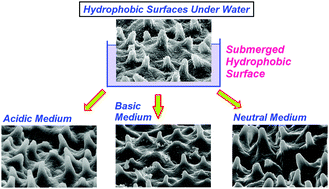Durability of submerged hydrophobic surfaces†
Abstract
Hydrophobic and superhydrophobic surfaces have gained wide popularity due to their potential in various areas such as in self-cleaning and anti-fouling materials, drag reduction and microfluidics. However, for all practical applications, the long term durability of these surfaces is extremely important, yet not often investigated. Of particular interest is the long term durability of soft hydrophobic surfaces that remain submerged underwater for a prolonged duration. In this article, we explore how the chemical durability of flat and patterned crosslinked PDMS surfaces (polydimethylsiloxane, a preferred material for microfabrication) change as a function of time when submerged in acidic, basic and neutral media for different durations over a prolonged period of time. Based on contact angle measurements, atomic force microscopy, confocal microscopy and SEM analysis of the surfaces, we checked if there is any change in the morphology of the surface due to deposition or etching. We created a biomimetic positive replica of a lotus leaf that exhibited super-hydrophobicity and Cassie state of wetting with a static water contact angle (θ) > 150°, and compared the degradation with a negative replica of lotus leaf (θ ∼ 127°), a grating patterned surface that exhibited Wenzel state of wetting (θ ∼ 110°) and a flat crosslinked PDMS surface (θ ∼ 105°). The positive replica maintained reasonable hydrophobicity (θ > 90°) for up to a month, but lost its super-hydrophobic property. The surface hydrophobicity degraded the most in the case of basic solution due to deposition.

- This article is part of the themed collection: Soft Matter Most Popular 2020


 Please wait while we load your content...
Please wait while we load your content...